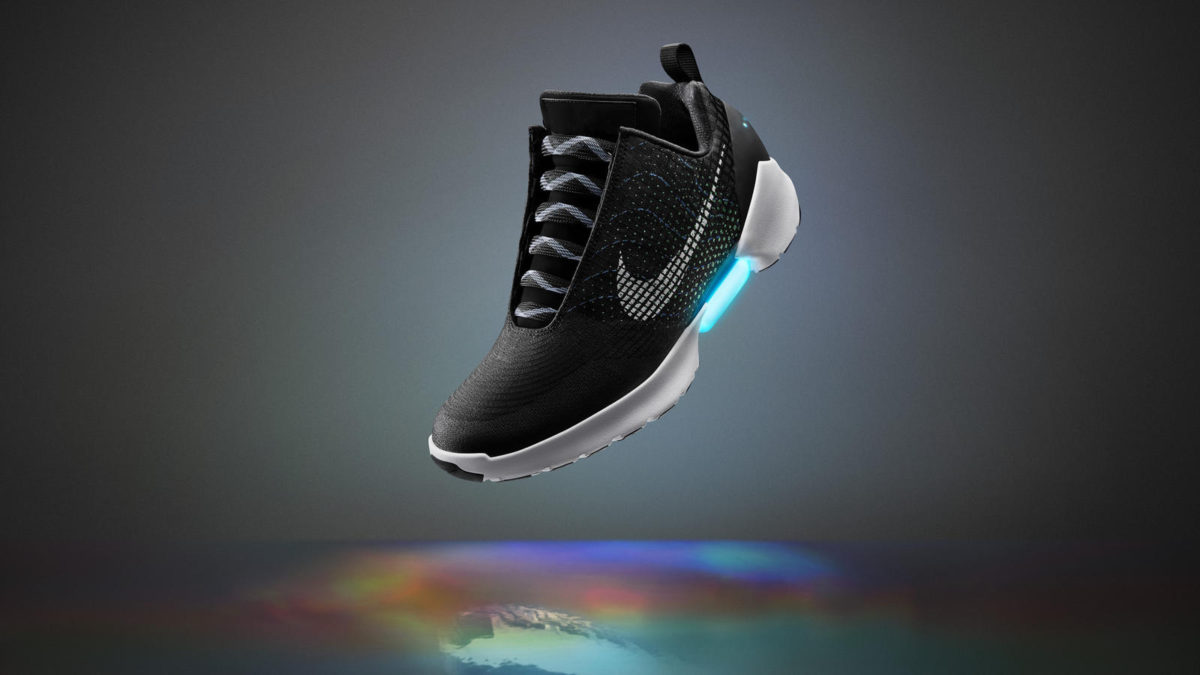What do sport apparel and digital innovation have in common? Probably more than you think.
Nike has gotten into the habit of introducing more than just “new seasonal colors” when they announce a new product line. It’s not that they don’t get fitness apparel right (I don’t think anyone has ever looked bad in Nike), it’s just that year after year, they bring their stylish gear to life and compliment it with really cool stuff (By the way, they actually have a position called “Footware Innovation Vice President”): first it was Fuel, then it was Nike+, then they introduced digital knitting and 3D printing athletes’ shoes, and now they’ve succeeded in bringing back the future (that was a Marty McFly reference) with adaptive lacing (more on that shortly).
Nike has been focusing tremendously on their digital strategy in the last years and what it can do for them to set them apart from their competition, and there is plenty of evidence proving why Nike continues to be the market leader after 50 years in the business.
In this post, I would like to talk about Nike’s active role in shaping 3 trends in athletic apparel and fitness communities:
- Platform applications to facilitate and encourage community training
- Personalized/tailored performance
- Technological enhancements in apparel and accessories
According to Mark Parker (President and CEO of Nike, aka best-job-for-free-gear), Nike’s digital community platform Nike+ offers what embodies the “era of personalized performance” to offer athletes a relationship rather than a dashboard (Dengate, 2016).
It all started with the Nike+ Running application, a collaboration with Apple wherein a running sensor allowed athletes to track their progress in distance, speed, and calorie burn (to my disappointment, it was missing a feature that tells you how many brownies you’re allowed to eat that day before breaking even with calorie count). But as always, Nike got more creative. Their new Nike+ App initiative connects its members to Nike+ Run Club (where they can run with the likes of Kevin Hart or just non-famous people in their city), as well as their Nike+ Training Club that offers on-demand training and coaching, the ability to book a class, and a personalized product store that suggests products for you based on your user activity, preferences, and size (Kell, 2016). It is also your link to Nike’s most limited products and has 10s of millions of users (Soni, 2014).
The idea is that your experience with Nike but also with fitness becomes personalized to trigger higher customer involvement and a bigger community amongst users.
Nike doesn’t want to be the only innovator adding value to their platform – their Nike+ Accelerator program helps developers build products and services using Nike’s user data and technologies that serve as complementary, value-added services. So not only are they connecting athletes, they’re connecting innovators to better connect athletes.

So now they’ve got a community together that has a personalized product store literally at their fingertips.
Nike’s move? …It prints some shoes and makes some other ones come alive.
Nike is no newcomer to digital creativity in sports apparel: their futuristic eyewear product line Magneto used to be their next big thing in 1994 (without going into too much detail here, the idea involved taping magnets to your face to clip eyewear onto them(Carr, 2013) – apparently athletes didn’t love the idea, can’t imagine why…).
But then came the FuelBand, allowing users to connect (or brag, let’s be honest) via social media whilst training, and it sent a clear message: Nike is transforming and is making the move towards tech, data, and services (Fast Company, 2013). FlyKnit came next, where Nike decided that digital knitting would be a thing in order to give athletes a seamless, one-piece upper shoe. And then came the new movement:
Tailored to the moment (Nike, 2016).
The SuperFly FlyKnit was mapped with biomechanical data from an athlete and a 3D printer then produced 30 iterations to tweak the configuration for stiffness and flexibility before finding her optimal fit. Finally, their Hyper Adapt shoe (dubbed EARL for “electro adaptive reactive lacing”), has introduced to the sports apparel world (at least those who can afford it), sport-informed adaptive lacing. To quote Nike, the shoe as a solution for idiosyncrasies in lacing and fit preferences is “precise, consistent, personalized, adjustable” (Nike, 2016). A sensor in the heel literally triggers the shoe to tighten to an ideal tension (Dengate, 2016) – the vision is that the shoe will one day be able to tighten with every step.
I know what you’re thinking – who cares, I can’t afford it anyway. But it would still be pretty cool (“excuse me while I quickly readjust the tightness of my shoe to the exact shape of my foot”). At least you can still run with Kevin Hart for free.

References:
Carr, A., 2013. Why Nike Killed Magneto, its Futuristic Eyewear Product. Fast Company. Accessed on: 26/09/2016. Available at: <https://www.fastcompany.com/3006410/most-innovative-companies-2013/why-nike-killed-magneto-its-futuristic-eyewear-product >
Dengate, J., 2016. Nine Things We Learned at Nike’s Innovation For Everybody Event. Runner’s World [Online]. Accessed on: 26/09/2016. Available at: <http://www.runnersworld.com/gear-check/nine-things-we-learned-at-nikes-innovation-for-everybody-event >
Fast Company, 2013. Nike: The Most Innovative Company of 2013. Fast Company. Accessed on: 26/09/2016. Available at: <https://www.fastcompany.com/most-innovative-companies/2013/nike>
Kell, J., 2016. This New Nike App is Like a Concierge For Working Out. Fortune Magazine [Online}. Accessed on: 26/09/2016. Available at: <http://fortune.com/2016/08/02/nike-new-app-social-ecommerce/>
Nike, 2016. Nike Debuts Wave of Innovation With Adaptive Lacing and Nike+ App. Nike.com. Accessed: 26/09/2016. Available at: <http://news.nike.com/news/mark-parker-adaptive-lacing-nike-plus>
Soni, P., 2014. Traditionally Innovative: The History of Nike. Market Realist [Online]. Accessed on: 26/09/2016. Available at: <http://marketrealist.com/2014/12/traditionally-innovative-the-history-of-nike/>

